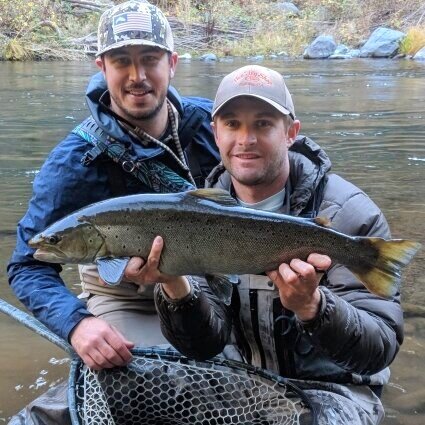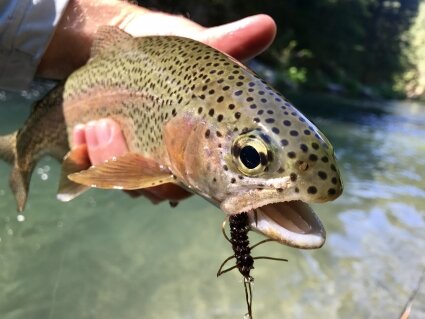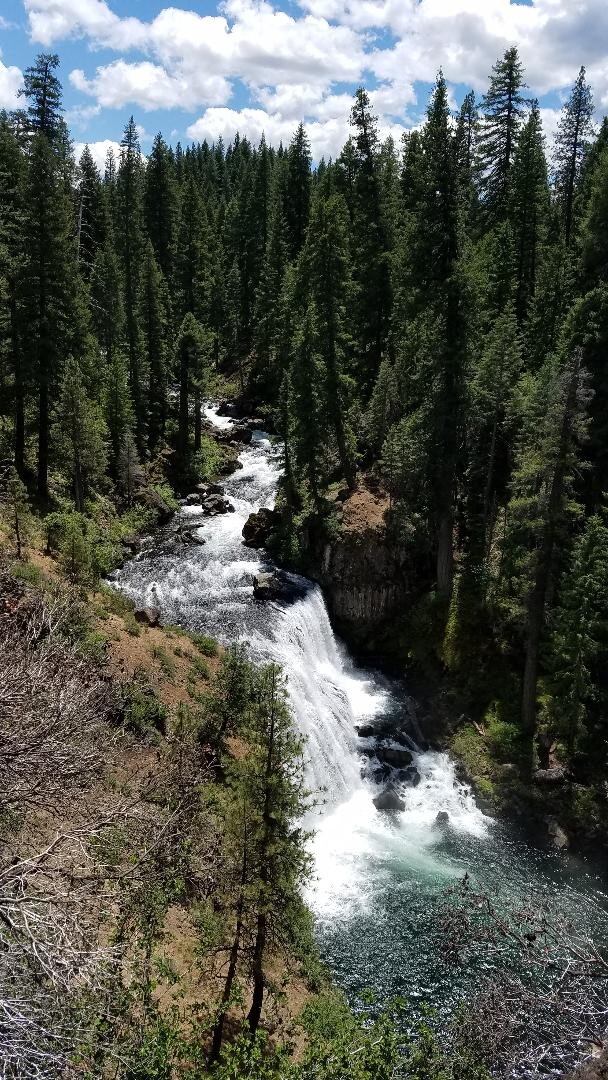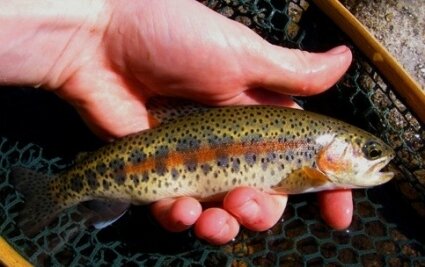McCloud River Fly Fishing Guide Trips
The McCloud River here in Northern California is a storied fishery, and with good reason! At the turn of the century eggs from the rivers genetically unique rainbows were carefully transported from the cool pristine waters and used to stock much of the continental U.S. and far off places such as New Zealand, Chile and Argentina. Dignitaries, railroad barons and even presidents have fished these waters. But the rainbows and history are only part of the reason why we come back to the McCloud time and time again.
The McCloud is located in some of the most scenic and remote country in California. ITs no wonder that anglers fall in love with this place!
This river is as unique and as picturesque a fishery as you could ever want with sections of pocked water that flow into an endless number of emerald pools, one after another. The river banks are covered with elephant ears and native grasses, while the canyons walls are lined with dense forest of hardwoods and evergreens. It is the remoteness of this canyon that has protected it and preserved the cool, oxygenated water unpolluted making it the ideal habitat for the rich biomass that the McCloud provides. Caddis, stoneflies, mayflies and midges can be found on the rocks, on surrounding vegetation and dancing in the air over the river. These insects provide an ever present source of food for not only the McCloud’s resident rainbows and browns as well as the larger browns that migrate up from the lake in the Fall.
The McCloud River seeps from underground aquifers just a few minutes East of I-5 off highway 89 near the town that shares its name. Located 5 hours north on San Francisco and 4 hours from Sacramento it is the quintessential freestone trout stream and well worth the drive for is scenery and productivity. There are two distinct portions of this river available to fly fishers, the area above and below Lake McCloud.
Anglers looking to fish the McCloud River can normally expect a good mixture of both nymphing and dry fly action, and at certain times of the year streamers can be quite productive. The McCloud is now open year round with special regulations.
A nice McCloud River brown!
Flow is highest in spring due to rain and melting snow. Fishable conditions generally arrive in mid-May. Summer, from late July to mid-September is hot and sunny so the McCloud fishes best early and late in the day. Arguably our favorite time to fish the McCloud is in the Fall when the October caddis hatch is o full swing, and in late fall when big browns up to 10 pounds migrate from the lake to the upper stretches of the Lower McCloud.
The River
Upper McCloud
The upper section of the river above the lake is quite scenic, and contains boulder-strewn gorges, two beautiful waterfalls (Upper and Lower McCloud) and lush green vegetation. This section is home to smaller fish water and most trout are planters under 10 inches. Most of the water in the upper area can be easily waded and good access allows fishermen, campers and folks looking to cool off access to the area during summer weekends. There are no special fishing regulations here. There are opportunities for those who are in search of something truly unique to hike up into the upper reaches of the river above the upper falls and target the McCloud River Red Bands. This is a genetically unique trout that qualify for the California Heritage Trout challenge, a fun and challenging program where participants catch 5 native California trout in their traditional drainages.
The Mac doesn’t lack in beauty!
Lower McCloud
The Lower McCloud is equally scenic however it holds larger fish in heavier water. It is less accessible and thus much less crowded. The river runs through a steep canyon and is surrounded by lush vegetation. Riffles are few and far between however the rivers emerald water cascades from one pool to another through boulders which create large deep pools for trout to hold in. Rainbows average 12 to 14" but some can exceed 20”. Resident browns average 16" but much larger ones migrate in during the Fall to spawn. Wading can be difficult due to water depth and flow, which can fluctuate due to dam releases. It is the cold water from below the dam that keep the McCloud around 52 to 56 degrees year round. Numerous feeder streams and springs also contribute to the size of the Lower McCloud. The river bank has access trails throughout most but not all of this section. The most isolated stretch is below Ash Camp, where the Pacific Coast Trail stays high above the river for three miles before curving away toward Ah-Di-Na campground. Look for a path down to the river about a half mile downstream. Wading in this area is tough, but fishing is excellent. Ash Camp, Ah-Di-Na and the McCloud River Nature Conservancy are three areas with slightly limited access but very productive fishing and unspoiled natural beauty.
Access to The Nature Conservancy portion of the McCloud River is limited to ten anglers each day. Half of those can be reserved in advance through their San Francisco office (415-777-0487) and the other five rods are allocated on a first-come, first-served basis. Click here to view their web site.
Our guides love fly fishing the McCloud River and is happy to share the techniques that have proven consistently successful on the river with our guests. If you are planning a fly fishing trip to Northern California, our guide staff can turn that average day into a truly memorable trip to this part of Northern California.
The Seasons
May and June:
May and June are generally considered the "prime time" months on the river. Starting as early as Opening Day (last Saturday in April), a myriad of insects begin to hatch on the McCloud, creating consistent opportunities throughout each day to catch fish on both nymphs and dry flies as well as streamers.
Beginning in late spring massive salmon flies begin to appear, hatching sporadically throughout the month of May and sometimes into early June. They are followed by numerous Golden Stoneflies and Little Yellow Stoneflies, all of which can get the McCloud River's numerous rainbow and brown trout rising on the surface. And even when the fish aren't focused on the flying adult insects, they'll readily take dead drifted stonefly nymphs in the McCloud's many pockets and deep pools.
In addition to the stoneflies, there are many other insects hatching on the McCloud during this time of year, including several species of caddis, PMD mayflies, and several other varieties and sizes of lesser mayflies. With so many different kinds of insects in the air, there are dry fly opportunities throughout the day, and many different kinds of nymph patterns will also produce strikes from aggressive fish.
July and August:
Summertime is a good time to be on the McCloud River sees. Although much of Northern California can be baking in sweltering heat, the McCloud remains shaded and cool at the bottom of a deep, heavily forested canyon and can continue to fish well all summer long with both nymphs and dry flies.
There are generally less insects hatching later in the summer, though Golden Stoneflies will still be found throughout much of the summer and caddis continue to come off every evening just before dark. The best dry fly opportunities will come late in the day, though nymphing the pockets and pools remains productive throughout the day. Summertime can be a great time of year for fishing streamers, too, targeting some of the bigger brown trout that reside in the McCloud's deep pools.
On dry, exceptionally warm summers, melting glaciers on Mount Shasta can pump silt-colored water into the lower McCloud River. Although the off-color water can be disconcerting at first, we've discovered over the years that it's not necessarily bad for the fishing. As long as there's a foot or more of visibility (which there usually is), the fish can still see your flies but they are less spooky and eat with much more confidence. Bigger, darker flies are more successful, and it is primarily a nymphing game. That said, the upper McCloud remains fishable and can be a good nearby option to get your dry fly fix.
October, November:
The Fall Season is a go to favorite for long-time McCloud River fanatics. Cool Fall nights usher in the October Caddis hatch, and there can be stellar blue-winged olive hatches on overcast days as well. Caddis casings can be seen littering every underwater rock starting in mid September and they begin to hatch at dusk in October and November. This can provide some brief yet frantic dry fly action late in the day. Attractor flies can work well even when a hatch is not going on and trout will eat the large larvae as well. Overcast days often see good hatches of Blue Wing Olives which can also provide some good dry fly action. Fall also coincides with the big bad browns migrating upriver from Shasta Lake. This can be a great time to swing streamers in the deep pools. Those who target these migratory fish know that this is not a numbers game but more about hunting for quality fish. Those who put in the work are often rewarded!
Fall is a great time to be chasing big browns on the McCloud!
McCloud River Guided Fly Fishing
Full day - Eight hours of guided fly fishing and instruction with lunch and bottled water provided - $625 (1 or 2 anglers)
We also provide rods, reels, flies and all terminal tackle on guided trips.
Note: California Fishing License, transportation and gratuities not included.
In addition to private guided fly fishing trips we also offer group and corporate fly fishing outings, classes and gift certificates.
Your McCloud River fly fishing adventure awaits! Call Now (707) 287-2939 for up to date fishing reports, current river conditions and information on experiencing enjoyable and memorable fly fishing for yourself. Dates fill up quickly for many of our offerings so don't delay. You may also fill out our Online Trip Request Form.
Come escape to the McCloud here in Northern California with us!














